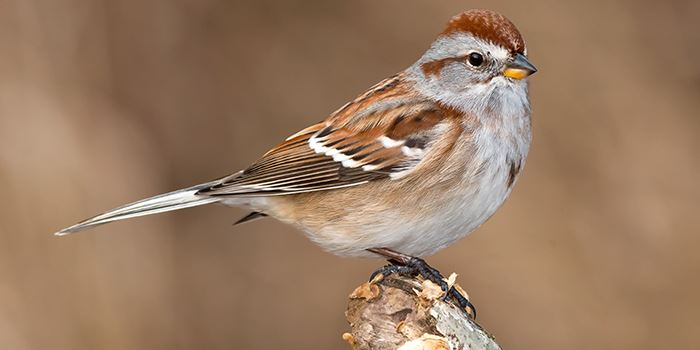Winter Chippies

By Karen Menard
Making their way through the cold December night sky, winged visitors from the far north clad in rusty red caps barrel toward northwest Ohio on a mission. American tree sparrows are headed south for the winter, to gather and flock in the open fields on the hunt for seeds and safe roosting habitat.
Soft, musical twitters are often heard before these birds are seen--emitted from the depths of dried stalks of goldenrods and grasses. With quick flashes of white wing bars, the feeding flocks will eventually flutter and rise, revealing the source of the mysterious arctic whispers.
As much of their time is spent scratching and pecking away at the ground for edibles, tree sparrows would be more aptly named “ground sparrows,” due to the fact that they are rarely viewed perched in a tree! Their name actually originated from the fact that their appearance reminded European settlers of Eurasian tree sparrows. The informal, affectionate term “winter chippy” is less commonly used, referring to the resemblance of the similarly sized chipping sparrow that also wears a rusty red cap.
American tree sparrows are actually birds of the tundra, spending our summer season nesting north of the tree line in northern Canada and Alaska. Large amounts of snow and ice on their breeding grounds impacts their ability to find consistent supplies of ample food most years, which spurs their winter migration south into the United States.
These longer tailed birds with a two-tone beak and dark spot on their chest, can easily be lured to a backyard feeding station using hulled sunflower seeds, millet, and cracked corn strewn on the ground. They can also be seen feeding in the Windows on Wildlife on snowy days.
Open meadow and prairie habitats in the Metroparks provide excellent foraging opportunities for these late season migrants, enabling them better success throughout the cold winter months and on their long, northern journey back home.
Did you know?
Tree sparrows can roost together underneath snow to keep warm. They are on the list of “Common Birds in Steep Decline,” due to experiencing a 50% decline in the last 50 years.